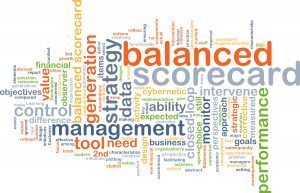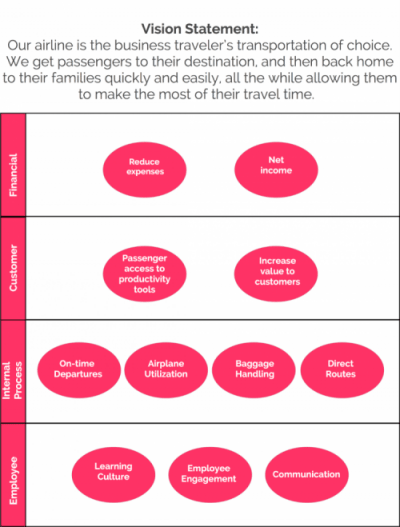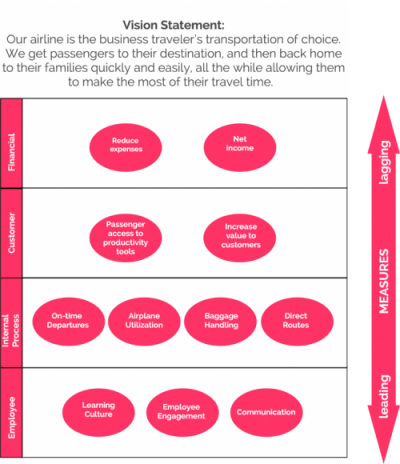We hope you enjoy this guest blog, an excerpt from the CFO Guide to Strategy Execution by Jennifer Eversole, CPA, Co-Founder & Partner, Management Stack, LLC. To read the full article please click here.
Or to watch Jennifer’s webinar Strategy Execution with a Balanced Scorecard click here.
After almost 20 years, I have learned more than I ever imagined I could from my experiences in the business world, and I’m certain that I have volumes yet to learn. I have worked with and studied companies who were able to articulate their vision, create a strategy, and execute the plan to achieve the vision and beyond. I have worked with others who fell flat, and yet others who never even got close to their goals.
All the drive and ability in the world won’t lead to sustainable success without a clear vision and business strategy that is continuously communicated across the organization. In other words, everyone needs to know:
- Where the company is going.
- How it is going to get there.
There are different ways to create and manage a company’s strategy. One way is to implement a Balanced Scorecard, which is a strategic planning and management system. The Balanced Scorecard was created by Drs. Robert Kaplan and David Norton in the 1990’s, though its roots go back many years. It began as a way to have a more balanced view of organization performance, by looking at both non-financial and financial measures. The concept eventually grew into a much larger strategic planning and management system that views success from multiple perspectives across the organization. The Balanced Scorecard provides much more than just a method for documenting the strategy, it provides a framework for executing it.
Strategy Execution
Vision
A strategy starts with a vision. A vision statements is inspirational, memorable, concise, clear, and easy to communicate. It should paint a picture of the future the company wants to create. A vision statement should also incorporate the company’s values and be ambitious, yet attainable. One way to get started creating a vision statement is to create a vision board. This exercise incorporates brainstorming, but with visuals, to get the creative juices flowing. Ask questions like:
- Who does the company help?
- Why does your company do what it does?
- What problem does your product or service solve?
- How do you want to make the world a better place with your product or service?
Get input from customers and employees. Then, seek feedback from family, friends, and anyone else who will listen and provide genuine feedback. In the end, the vision statement should ignite passion in leaders, employees, customers, and stakeholders.
Here are some real-life examples of great vision statements:
Google: To provide access to the world’s information in one click.”
Amazon: Our vision is to be earth’s most customer centric company; to build a place where people can come to find and discover anything they may want to buy online.
Zappos: One day, 30% of all retail transactions in the US will be online. People will buy from the company with the best service and the best selection. Zappos.com will be that online store.
Make-A-Wish: Our vision is that people everywhere will share the power of a wish.
NPR: NPR, with its network of independent member stations, is America’s pre-eminent news institution.
Objectives
In a Balanced Scorecard, objectives are key areas in which the company must focus in order to get where it wants to go. The company can take a look at where it is now, and where it wants to go and identify those areas in which it must focus to get from here to there. Identifying objectives requires that leaders take a hard look at the organization and identify strengths that it can capitalize on as well as weaknesses that must be overcome. A good place to start is with a SWOT analysis. Objectives should be grouped into various perspectives, and objectives should be aligned with the other perspectives. Typically, the perspectives are:
- Financial
- Customer
- Internal Process
- Employee (Learning & Growth)
Employee Perspective
Starting with the foundation, the employee perspective, ask yourself, “How will we continue to learn and grow?” Using a fictitious airline company as an example, we could name the following employee perspective objectives:
- Promote a culture of learning
- Increase employee engagement
- Continuous communication
Internal Process Perspective
From the employee perspective, we move up to the internal process perspective. Here, ask yourself, “At which processes must we excel in order to succeed?”. Think of the activities and processes from end to end. Examples of objectives in the internal process perspective are:
- Improve on-time departures
- Increase airplane utilization
- Improve baggage handling accuracy
- Increase percentage of direct routes
Customer Perspective
For this perspective, ask the question “What does our success look like from our customer’s perspective.” Perhaps, the answer to that is that the customers are consistently able to use travel time to increase productivity or that the customer perceives the value as greater than the price. From those answers, you can pull the following objectives:
- Increase passenger access to productivity tools
- Increase value delivered to customer
Financial Perspective
Finally, when you reach the financial perspective, ask “What does financial success look like to our shareholders?” Depending on where the business is in its lifecycle, financial goals may be different. For example, companies in a startup or heavy growth phase usually need funds to reinvest, so the financial goals may be largely related to retaining cash. Other companies who have reached maturity may be more concerned with return for investors. Financial objectives might include:
- Reduce expenses
- Increase Net Income
Putting it Together: The Strategy Map
The visual representation of the objectives grouped by perspective is a strategy map. Collectively, the objectives tell the story of the company’s strategy and let everyone know how the company plans to achieve the vision. In general, improving objectives in the employee perspective enables improvement in objectives in the internal process perspective, which then leads to better performance in the customer and financial perspective objectives.
Measures
Measures are key performance indicators that tell the company whether the objectives are moving in the right direction. Measures can be leading indicators or lagging indicators. Lagging indicators are the KPIs that follow an event and report on a past event. For example, net income is a lagging indicator that reports financial results for a prior period. Leading indicators, on the other hand, are KPIs that predict future events. These are measures like employee engagement. Higher levels of employee engagement drive improvements in operational results across the rest of the organization. Measures in the financial perspective will most likely be entirely lagging indicators. As you move down through the scorecard to the employee perspective, the measures will consist primarily of leading indicators.
Finally, initiatives are the projects or activities that are implemented to move the objectives forward. It is with this step that strategy is truly translated to action. Giving people projects or tasks that are associated with objectives that directly lead to the vision allows people to see how their efforts contribute to the company’s success in achieving it’s vision.
A team of engaged employees is a critical success factor that can drive sustainable success, but they must have a framework in which to make decisions. The Balanced Scorecard strategic planning and management system is one way in which companies can communicate the vision and story of the strategy in the form on a strategy map.
The Balanced Scorecard and Budgeting
A Balanced Scorecard can take many months to implement and requires commitment from those at the top. Leaders should have an open mind and be ready to embark on an exercise of organizational self-discovery.
Once successfully implemented, however, the Balanced Scorecard can serve as a much-needed pathway to success in achieving the company’s vision. And the budgeting process offers as an important link to strategy execution – or putting the Balanced Scorecard strategy into action.
Budgeting provides a framework to help organizations align finances to the initiatives and priorities identified in the Balanced Scorecard. The budget can be used to communicate and reinforce the organization’s strategic plan, and to ensure that the necessary resources have been allocated to achieve these objectives.



